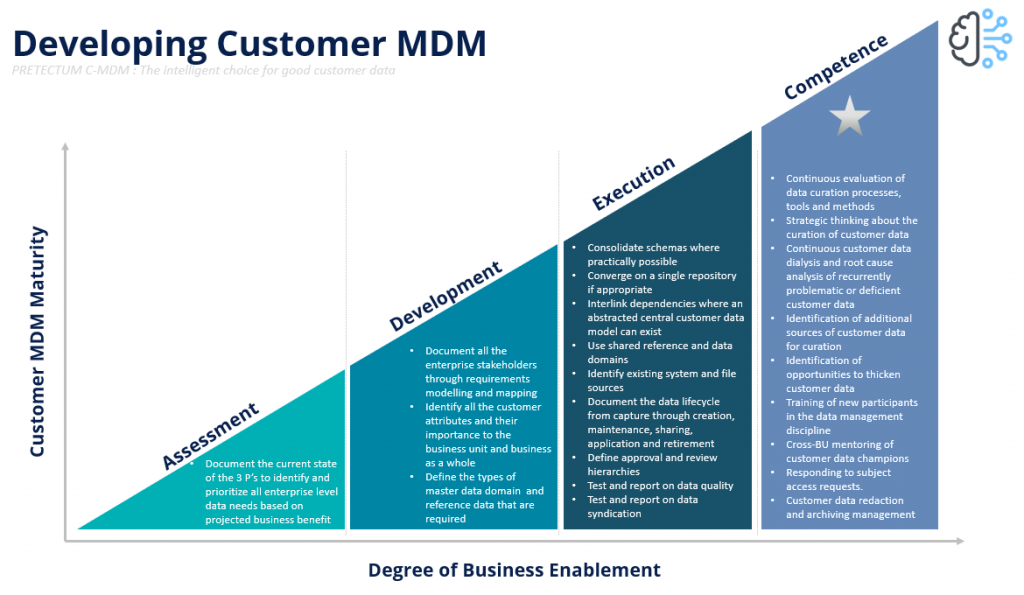Businesses are under “data pressure” with data itself coming in and flowing out in every direction. Customer interactions, financial transactions, product and supply chain logistics. The volume of information can sometimes seem overwhelming.
But what if you could harness this data to drive growth and efficiency?
Customer Master Data Management (CMDM), is the solution for probably one of the most valuable and important data assets that a business may have. Customer profile master data is essential for enhancing decision-making and optimizing customer relations.
The Pretectum CMDM platform provides a comprehensive solution to the common problem of data pressure and chaos that modern organizations have to endure. Implementing a CMDM strategy can ensure greater data accuracy, greater data consistency, and improved data accessibility across all departments. We’ll consider what we believe to be the five essential steps to business transformation with Pretectum CMDM at the center.
Assessment – Before diving into the specifics of what CMDM might mean, it’s necessary to understand your current data environment and practices. This is best achieved by conducting a thorough audit of your existing data sources, systems, and processes. What you might consider as a typical customer master data maturity model assessment. In this exercise you’ll identify areas where data is siloed, inconsistent, or outdated. Such an assessment serves as foundational for establishing any CMDM strategy. The exercise highlights the specific challenges and opportunities that are within your organization or which it may be facing.

Master Data Management Goals – Once you’ve assessed your assessment, the next step is to define clear, actionable goals for CMDM. Your organization might be looking to grow retention numbers, establish consent, improve data accuracy, enhance customer insights, or simply streamline operations? Setting specific objectives will guide your MDM strategy and ensure alignment with your overall business goals.
Choose the right solution – If you plan to automate your customer MDM, selecting the right CMDM solution is critical to the success of your initiative. Pretectum CMDM offers a flexible, scalable SaaS platform that can be tailored to meet the unique needs of your business. With features like customizable customer data profiles, bulk upload and real-time data synchronization, self-service data curation with consent, data quality assessment, deterministic and fuzzy duplicate matching, data masking, encryption natural language search within user-friendly interfaces, Pretectum CMDM leads in Customer MDM.
Integrating CMDM Solutions – With your customer data profile management goals defined and one or more solution selected, it’s time to implement and integrate your CMDM system. You’ll need to determine your approach to MDM. This will also involve configuring the software to align with your business processes, training team members, and ensuring robust and reliable integration with existing systems. Pretectum CMDM provides an easy to use front end and documentation as well as technology support throughout this process, ensuring a smooth transition and minimal disruption to your operations.

Monitor, Optimize, and Evolve – CMDM is not a one-off project. It is an ongoing process. Regular monitoring of your data quality and system performance to identify areas for improvement, using analysis to gain insights into your data and make informed decisions. As your business evolves, your CMDM strategy should evolve too. Pretectum CMDM offers continuous availability and application support with updates to keep your system running at peak performance.
Building Trust – Pretectum CMDM’s unique selling points is its alignment with the needs of most businesses in terms of recommendations and not prescriptions. Our approach is to support your business in the way it prefers.
The user-friendly interface, customizable features, and exceptional customer support with regular releases means you can start small and extend your use as you and your business grow. Our platform addresses common pain points such as data silos, inconsistent data, and integration challenges. By choosing Pretectum CMDM, you’re investing in a solution that not only meets current needs but will scale with your business.

If you’re ready to transform your business with Master Data Management, contact us today to schedule a conversation, a demo or a trial of Pretectum CMDM and discover how our solution can drive growth and efficiency in your organization.


